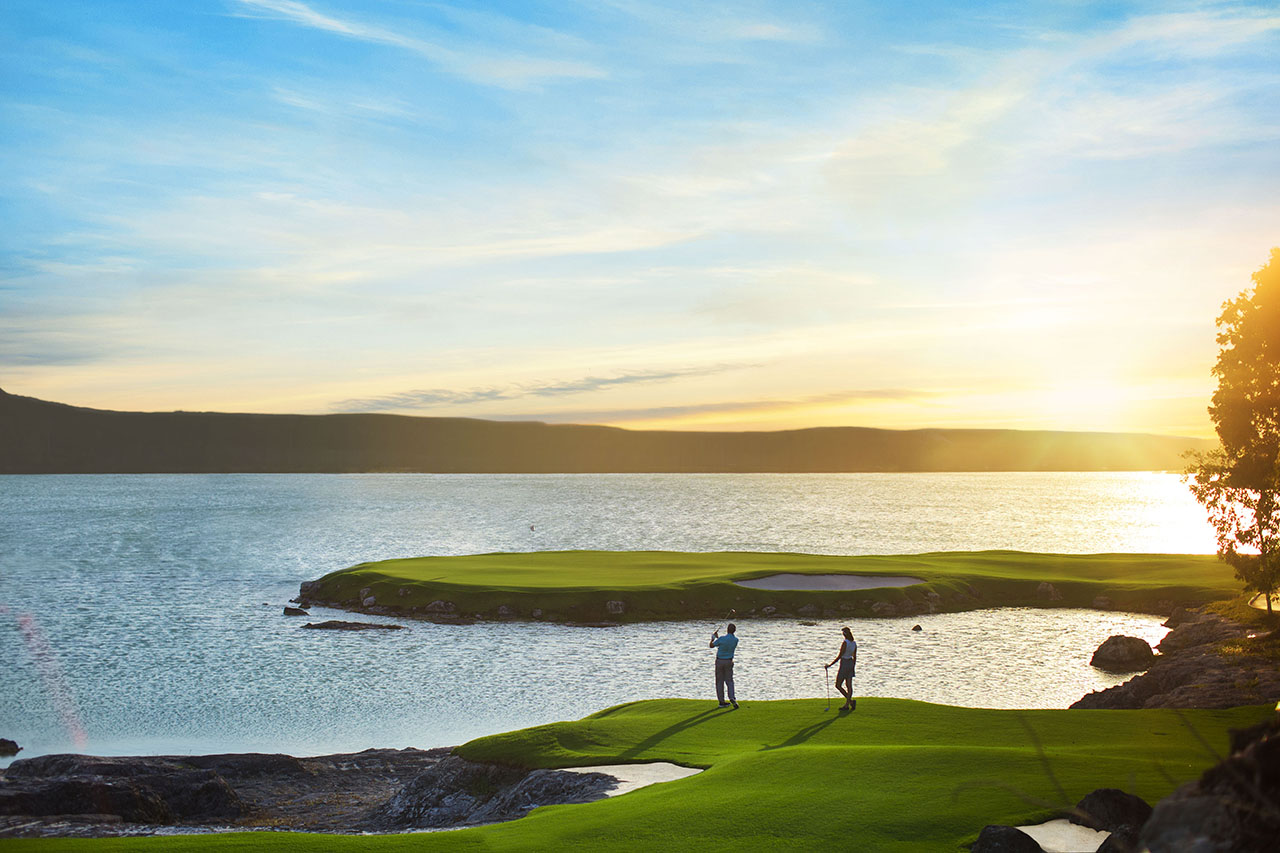NASSAU, The Bahamas – From the 16th tee at Royal Blue, perched high above the green on the spectacular Jack Nicklaus Signature Golf Course at the uber-elegant Baha Mar Resort, there’s a sense you’re taking in the best the course offers.
The green isn’t on an island, rather a peninsula that juts into Lake Cunningham, taunting those above with a come-hither look but a difficult-to-hold putting surface. Although turquoise waves lap at Cable Beach close by, the lake water along the picturesque 16th is typically calm and dark, an unfortunate grave for far too many mis-hit shots.
Nerves are certain to be tested by this point in the round, as the course has wound through an irregular diet of holes, some that appear to be former swamp and others that look as if they could have been carved through the limestone-laden Queen’s Staircase, a popular tourist attraction in nearby Nassau.
Baha Mar in Nassau, the Bahamas, features three hotels: the Grand Hyatt, the SLS and the Rosewood. (Courtesy of Baha Mar)
Either elated or infuriated, players making their way out to the 16th green often have an epiphany of sorts — the look back toward the tee is even more striking as it reveals a series of rockscapes that look as if they could have been traversed by Neil Armstrong and Buzz Aldrin. As odd as it may sound, it might be more interesting to look back on the 16th hole than to look forward. And considering how magnificent the view is looking forward, that’s an accomplishment.
But it’s also a perfect encapsulation of the entire resort, one that has risen from the ashes after once flaming out. Looking back at Baha Mar’s history might be just as interesting as looking ahead to its certain-to-be-brilliant future.
Golfweek’s Best 2023: Top 50 courses in Mexico, Caribbean, Atlantic islands and Central America
Because Baha Mar isn’t just a story of opulence and indulgence, but perseverance and persistence.
Before Royal Blue came to pass, another golf course sat on this property just west of the Bahamian capital, an additional chunk of bait used to lure potential travelers to this remote paradise. The course, then known as Cable Beach Golf Club, was loosely associated with the British Colonial Hotel nearly four miles to its east, and offered Floridians (and others from the nearby Southeast United States) a slice of home — a flat, tricky run of holes with a constant threat of water.
Jack Nicklaus designed the Royal Blue course at Baha Mar. (Courtesy of Baha Mar)
When Nicklaus’ group came in to revamp and add to what is now Royal Blue, designers stuck to the game plan, and smartly so. Although the front feels familiar, it’s an interesting run with just enough places to bail out and avoid the wet stuff.
As long as you can stay dry, the first few holes at Royal Blue ease you into the round. Views of the resort are ever-present in the opening stretch. Aside from the lengthy second hole, which is lined by a lake, it’s within reason for even average players to post a good number at the turn. Of course, staying dry isn’t exactly easy as considerable water hazards line eight of the first nine holes. Only the par-4 fifth is without water on the front, and that hole has so many bunkers it feels like an entire nearby beach must have been sacrificed.
And who’s to say any of this is easy? The resort itself has had trouble avoiding hazards, even those that seemed simple to navigate.
Originally a can’t-miss project in the hands of a billionaire native son – whose father had made his fortune through a monopoly of sorts in the peanut industry – the financial crisis of 2008 brought plans to a screeching halt. A Chinese conglomerate produced financing to pick the project back up, but then a steady flow of Chinese workers was imported, bypassing a largely unemployed island workforce. This wasn’t well-received by locals, who would often ridicule the project as a folly.
In 2016, before ever opening its doors and with work nearly complete, the resort declared bankruptcy, and it appeared this pristine combination of golf and surf would never get its day in the sun.
Fortunately a Hong Kong-based holdings company finally got the ball over the goal line, and guests have been coming ever since to three hotels — the aptly-named Grand Hyatt, which houses the vast majority of Baha Mar’s 2,300 rooms, the ritzy SLS and the super-swanky Rosewood.
As you’d expect, there’s more to do at Baha Mar than golf, as the largest casino in the Bahamas is surrounded by more than a dozen high-end restaurants, bars and lounges, including my favorite, Costa, offering upscale Mexican fare inside the elegant Rosewood. (I recommend lobster tacos and a side of brussels sprouts and mole.)
A lazy river flows at Baha Mar (Courtesy of Baha Mar)
But if you make it to Baha Mar, you do need to golf, mostly to be able to see a back nine that weaves its way through limestone and fun, starting with the short but interesting 10th hole, which drops from an elevated tee into what feels like a quarry.
Unlike the front, there’s almost no water on the back aside from the aforementioned 16th and the fairways aren’t quite as tight, but there’s still plenty of trouble to be found. On No. 14, for example, the second shot on the par 4 comes into a green that’s unprotected on the front. Pull the ball left, however, and you’re certain to find jail in a thick batch of Caribbean pine that will be tough to wriggle free from. Misjudge the distance and hit it long, which is easy to do with an uphill approach, and you’ll find a 15-foot-tall limestone embankment that has been known to rocket the ball back as fast (and almost as far) as it came in.
After the tricky shot on 16, a pair of holes climb to the finish with 18 again using a wall of limestone and some well-positioned bunkers to give players one last thrill ride.
With a series of free-flowing tee boxes, Royal Blue can play as long as 7,189 yards, but it’s best to see the course from the distance that suits you best. “They’re suggestions,” said Andy Deiro, the director of golf and resident Kansas City Chiefs fan, when asked about the tee placements on the massive staging areas. “Have fun with them.”
A pool at Baha Mar (Courtesy of Baha Mar)
After the history Baha Mar has survived and emerged from, that’s probably good advice.
The future looks bright at a resort that wound up costing more than $4 billion to complete. Royal Blue has triumphantly risen to No. 1 in Golfweek’s Best rankings in the Bahamas and top 20 overall on the 2022 list of top golf courses in Mexico, the Caribbean, the Atlantic islands and Central America.
But there have been many bleak moments in the not-too-distant past when it looked like this piece of paradise might never see players again come through.
With a lack of drawbacks — perhaps the only one I can even muster is a lack of genuine beachfront views — there’s plenty to look forward to, for certain. Looking back at the property’s history makes that view even more worth savoring.








